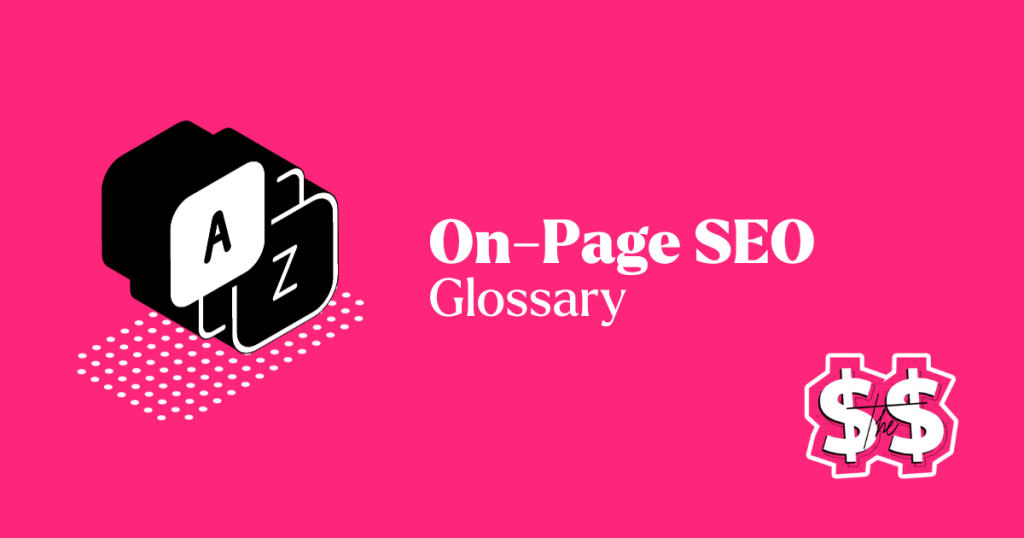On-page SEO refers to the optimization techniques used on a website’s individual pages in order to improve its ranking and visibility on search engine results pages (SERPs). This includes optimizing content, titles, meta descriptions, images, and other elements to make them more relevant and attractive to search engines and users.
- On-Page SEO: Optimization techniques applied directly on a website to improve its visibility, including content, HTML, and meta tags.
- SEO (Search Engine Optimization): The practice of optimizing individual web pages to rank higher in search engine results and attract organic traffic. (ref.: SEO glossary)
- Meta Title: An HTML tag that defines the title of a webpage, appearing in search engine results and browser tabs.
- Meta Description: A concise summary of a webpage’s content, displayed in search results beneath the meta title.
- Meta Tags: HTML tags that provide additional information about a webpage to search engines, including meta titles, meta descriptions, and meta keywords.
- Header Tags (H1, H2, H3, etc.): HTML tags used to define headings and subheadings on a webpage, indicating content hierarchy.
- URL Structure: The organization and format of a webpage’s URL, influencing search engine rankings.
- Keyword Density: The percentage of times a target keyword appears in the content compared to the total word count.
- Alt Text: Descriptive text added to an image’s HTML code, aiding search engines in understanding the image content.
- Canonical URL: The preferred version of a URL when multiple URLs contain identical or very similar content.
- Internal Linking: The practice of linking to other pages within the same website to improve navigation and distribute link equity.
- External Linking: Including hyperlinks on a webpage that lead to other websites, providing additional context and credibility. (ref.: link building glossary)
- Content Quality: The overall value, relevance, and usefulness of the content on a webpage.
- Keyword Research: The process of identifying relevant keywords to target in on-page SEO efforts.
- LSI Keywords (Latent Semantic Indexing): Keywords related to the main target keyword, providing context and relevance. (ref.: semantic SEO glossary)
- Keyword Placement: The strategic inclusion of keywords in specific areas of a webpage, such as titles, headings, and body text.
- Content Freshness: The recency and relevance of content, influencing search engine rankings.
- Page Loading Speed: The time it takes for a webpage to load, impacting user experience and search rankings.
- Mobile Optimization: Adapting a webpage to ensure optimal performance and user experience on mobile devices.
- Responsive Design: A design approach that ensures a webpage displays correctly on various devices and screen sizes.
- User Experience (UX): The overall experience a visitor has on a webpage, considering design, navigation, and content.
- Multimedia Content: Including images, videos, and other media types to enhance the richness of a webpage.
- Readability: The ease with which users can read and understand the content on a webpage.
- Keyword Proximity: The closeness of keywords to each other within a webpage’s content, impacting relevance.
- Schema Markup: A structured data markup added to HTML to provide search engines with more informative results.
- Content Formatting: The arrangement and presentation of text, images, and other elements on a webpage.
- Breadcrumbs: Navigational links that show a user’s location on a website, often appearing above the content.
- Social Sharing Integration: Including social media sharing buttons and features to encourage content sharing.
- Call-to-Action (CTA): An element prompting users to take a specific action, such as making a purchase or filling out a form.
- Robots Meta Tag: An HTML tag that instructs search engine crawlers on how to index and follow links on a webpage.
- User Intent: Understanding the purpose and expectations behind a user’s search query.
- Page Title Tag: The HTML tag defining the title of a webpage, appearing in the browser tab and search results.
- Snippet Optimization: Crafting concise and informative snippets that appear in search results, often using structured data.
- Image Compression: Reducing the file size of images to improve page loading speed without sacrificing quality.
- Keyword Stuffing: The unethical practice of overloading a webpage with irrelevant keywords in an attempt to manipulate rankings.
- Above-the-Fold Content: The content visible on a webpage without scrolling, considered important for user engagement.
- Content Headings Structure: Organizing content with clear headings and subheadings to enhance readability and SEO.
- Internal Link Anchor Text: The clickable text used in internal hyperlinks, providing context about the linked page.
- SSL Certificate: A security protocol that ensures data encryption between a user’s browser and the website server.
- Content-Length: The word count or character count of a webpage’s content, influencing SEO.
- Link Juice: The value or equity passed from one page to another through hyperlinks.
- Orphan Page: A webpage without internal or external links, potentially lacking visibility.
- Header Structure: The organization of headers, including H1, H2, and H3 tags, contributing to content hierarchy.
- Keyword Prominence: The importance and visibility of keywords within a webpage’s content.
- Inbound Links: Links coming from external websites to a specific webpage.
- Outbound Links: Links from a webpage leading to other external websites.
- Link Relevance: The contextual connection between linked pages, impacting SEO.
- Content Siloing: Grouping related content into thematic silos to enhance organization and SEO.
- Duplicate Content: Identical or substantially similar content appearing in multiple locations, potentially affecting search rankings.
- Structured Data: Information presented in a format that search engines can easily understand, often implemented with schema markup.
- Canonicalization: Choosing the preferred version of a URL when duplicates exist to avoid duplicate content issues.
- AMP (Accelerated Mobile Pages): A technology that enhances mobile web performance by delivering lightweight pages.
- Keyword Cannibalization: The unintentional competition between multiple pages of a website for the same keyword.
- Content Audit: A systematic review of existing content to assess quality, relevance, and performance.
- Content Interlinking: Linking between related pages within a website to improve navigation and user experience.
- Image SEO: Optimizing images for search engines by using descriptive file names and alt text.
- Transactional Content: Content designed to facilitate transactions or conversions, such as product pages.
- Informational Content: Content intended to educate or inform, often found in blog posts or articles.
- Keyword Synonyms: Words with similar meanings to the target keyword, providing variety in content.
- Content Cornerstone: A comprehensive and authoritative piece of content covering a specific topic or keyword.
- Above-the-Fold Optimization: Enhancing the user experience and visibility of key content without scrolling.
- User-Generated Content (UGC): Content created by users, such as reviews or comments.
- Review Snippet: A short excerpt from a review displayed in search results, often using schema markup.
- Structured Data Testing Tool: A tool provided by Google to validate structured data on a webpage.
- Breadcrumb Navigation: A navigational aid that displays a user’s location on a website, improving user experience.
- Content Keyword Cannibalization: The unintentional targeting of the same keyword across multiple pages, causing competition.

On-page SEO is the practice of optimizing individual web pages in order to rank higher and earn more relevant traffic in search engines. Some examples of on-page SEO tactics include using relevant keywords in the title, meta description, and headings of a web page, creating high-quality and relevant content, and optimizing images and videos with relevant file names and alt tags. The goal of on-page SEO is to make a web page more valuable and relevant to both users and search engines, ultimately resulting in higher rankings and more organic traffic.
